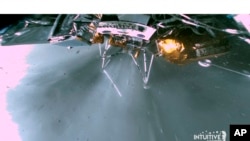ຍານອະວະກາດລຳທຳອິດຂອງສະຫະລັດ ທີ່ໄດ້ລົງຈອດເທິງດວງເດືອນ ນັບຕັ້ງແຕ່ບັນດານັກບິນອະວະກາດຂອງອາໂປໂລນັ້ນ ໄດ້ມິດງຽບໄປເມື່ອວັນ ພະຫັດວານນີ້ ນຶ່ງອາທິດຫຼັງຈາກທີ່ຂາເບື້ອງນຶ່ງໄດ້ຫັກເວລາບິນລົງຈອດ ແລະໄດ້ລົ້ມລົງໃກ້ຂົ້ວກ້ຳໃຕ້ຂອງດວງເດືອນ.
ຍານດັ່ງກ່າວຂອງບໍລິສັດ Intuitive Machines ຊື່ວ່າ Odysseus ມີອາຍຸ ຍືນກວ່າທີ່ບໍລິສັດໄດ້ຄາດໄວ້ ຫຼັງຈາກມັນໄດ້ລົ້ມລົງທາງຂ້າງ ພ້ອມດ້ວຍພະລັງງານແສງຕາເວັນ ແລະການສື່ສານດຳເນີນການຢ່າງບໍ່ປົກກະຕິ.
ການສິ້ນສຸດໄດ້ມີຂຶ້ນຂະນະທີ່ບັນດາຜູ້ຄວບຄຸມການບິນ ໄດ້ຮັບຮູບພາບອັນສຸດ ທ້າຍຈາກຍານ Odysseus ແລະໄດ້ອອກຄຳສັ່ງແກ່ຄອມພິວເຕີ ແລະລະບົບ ພະລັງງານຂອງມັນໃຫ້ກຽມພ້ອມປະຕິບັດການ. ວິທີທາງນັ້ນ ຍານອະວະກາດ ດັ່ງກ່າວຈະສາມາດຕື່ນຂຶ້ນມາໄດ້ອີກພາຍໃນສອງຫາສາມອາທິດ ຖ້າມັນລອດ ຊີວິດຈາກຄ່ຳຄືນແຫ່ງຄວາມໜາວຈັດຂອງດວງເດືອນ.
ໂຄສົກຂອງບໍລິສັດ Intuitive Machines ທ່ານຈອສ ມາຣໂຊລ ໄດ້ກ່າວວ່າ ບາດກ້າວສຸດທ້າຍທັງຫຼາຍເຫຼົ່ານີ້ ໄດ້ລະບາຍໝໍ້ໄຟຂອງຍານອະວະກາດ ແລະເຮັດໃຫ້ຍານ Odysseus “ຫລັບລົງເປັນເວລາຍາວນານ.”
“ລາຕີສະຫວັດ, ໂອດີ. ພວກເຮົາຫວັງວ່າ ຈະໄດ້ຍິນສຽງຈາກເຈົ້າອີກເທື່ອນຶ່ງ” ບໍລິສັດໄດ້ກ່າວຜ່ານທາງ X ທີ່ເປັນອະດີດສື່ສັງຄົມ ທວິດເຕີ.
ກ່ອນທີ່ຈະມອດໄປຍານ Odysseus ໄດ້ສົ່ງສິ່ງທີ່ບໍລິສັດ Intuitive Machines ເອີ້ນວ່າ “ການສົ່ງສັນຍານສັ່ງລາທີ່ເໝາະສົມ.”
ຮູບພາບທີ່ໄດ້ຖ່າຍກ່ອນການບິນລົງຈອດນັ້ນ ສະແດງໃຫ້ເຫັນ ເບື້ອງລຸ່ມຂອງ ຍານອະວະກາດຢູ່ເທິງພື້ນຜິວຂອງດວງເດືອນທີ່ເປັນຂຸມ ພ້ອມດ້ວຍແສງສ້ຽວ ນ້ອຍໆຂອງໂລກ ແລະດວງຕາເວັນ ຢູ່ດ້ານຫລັງ.
ຍານອະວະກາດດັ່ງກ່າວ ໃນເບື້ອງຕົ້ນມີຈຸດປະສົງທີ່ຈະຢູ່ລອດເທິງດວງເດືອນ ປະມານນຶ່ງອາທິດ.
The first U.S. spacecraft to land on the moon since the Apollo astronauts fell silent Thursday, a week after breaking a leg at touchdown and tipping over near the lunar south pole.
Intuitive Machines' lander, Odysseus, lasted longer than the company anticipated after it ended up on its side with hobbled solar power and communication.
The end came as flight controllers received one last photo from Odysseus and commanded its computer and power systems to standby. That way, the lander can wake up in another two to three weeks — if it survives the bitterly cold lunar night.
Intuitive Machines spokesman Josh Marshall said these final steps drained the lander's batteries and put Odysseus "down for a long nap."
"Good night, Odie. We hope to hear from you again," the company said via X, formerly Twitter.
Before losing power, Odysseus sent back what Intuitive Machines called "a fitting farewell transmission."
Taken just before touchdown, the picture shows the bottom of the lander on the moon's pockmarked surface, with a tiny crescent Earth and a small sun in the background.
The lander was originally intended to last about a week on the moon.
Houston-based Intuitive Machines became the first private business to land a spacecraft on the moon without crashing when Odysseus touched down February 22. Only five countries had achieved that since the 1960s, including Japan, which made a sideways landing last month.
Odysseus carried six experiments for NASA, which paid $118 million for the ride. The first company to take part in NASA's program for commercial lunar deliveries never made it to the moon; its lander came crashing back to Earth in January.
NASA views these private landers as scouts that will pave the way for astronauts set to arrive in another few years.
Until Odysseus, the last U.S. moon landing was by Apollo 17's Gene Cernan and Harrison Schmitt in 1972.











ຟໍຣັມສະແດງຄວາມຄິດເຫັນ